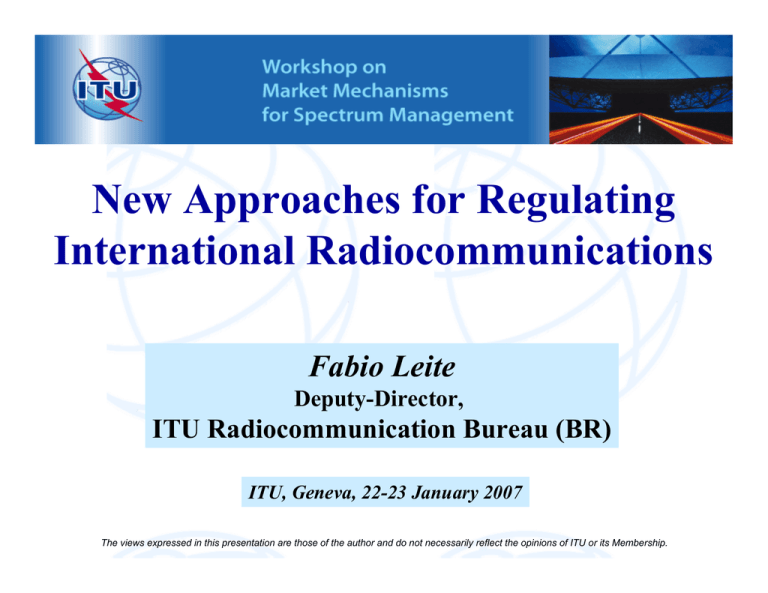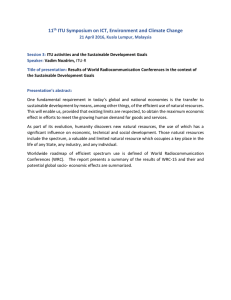New Approaches for Regulating International Radiocommunications Fabio Leite ITU Radiocommunication Bureau (BR)
advertisement

New Approaches for Regulating International Radiocommunications Fabio Leite Deputy-Director, ITU Radiocommunication Bureau (BR) ITU, Geneva, 22-23 January 2007 The views expressed in this presentation are those of the author and do not necessarily reflect the opinions of ITU or its Membership. Spectrum Management Processes Radio Regulations International level Table of Frequency Allocations WRC Regulatory Procedures National Regulatory Authority Public consultation Spectrum Planning, Licensing & Monitoring MIFR National level Frequency Registry WRC Process ITU Member States (189) Advanced technologies Revisions to RR, Resolutions & Recommendations Final Acts Technical bases Rec RR WRC CPM RRB Director RadiocommunicationBureau Bureau Radiocommunication SGs & SC RofP Findings CPM: Rec: RofP: RR: Conference Preparatory Meeting ITU-R Recommendation Rules of Procedure Radio Regulations (treaty status) No harmful interference MIFR MIFR: Master International Frequency Registry RRB: Radio Regulations Board SGs: Radiocommunication Study Groups WRC: World Radiocommunication Conference Regional Spectrum Management 9Harmonization of national frequency allocations within the relatively flexible framework set by ITU so as to allow for the coordinated introduction of new services; 9 Harmonization of the standards and procedures for certification of equipment with a view to its free circulation and use in the countries concerned. National Spectrum Management … Factors ↔ conditions Flexibility ↔ international obligations Market mechanisms ↔ social aspects, governmental, safety & scientific uses Technical complexities ↔ graceful transitions, impact on other uses Different solutions for different services/situations/uses (a-priori planning, “command & control”, commons, trading, auction) The changing wireless environment Treaty-based Radio Regulations FLEXIBILITY Service & technology definitions IP/ CONVERGENCE Standards-based equipment Technological INNOVATIONS Telecom Operator (State-owned/monopoly) COMPETITION Sector Bilateral/multilateral REFORM agreements Proprietary systems Licensing Detailed spectrum allocation MARKET-driven regime Property-rights/trading/ licence-exemption Multiple platforms Flexible allocation Multiple private operators Regulator NEUTRALITY Options for improvement of the international spectrum regulatory framework CONVERGENCE SERVICE Fixed, mobile, broadcasting New applications WRC Process FLEXIBILITY TECHNOLOGY IP-core networks UWB, HAPS, SDR mobile-TV RR SERVICE DEFINITION Fixed, mobile, broadcasting Spectrum HARMONIZATION Regional, global New allocations no change mod service definitions principle of substitutability (fixed/mobile) Flexibility less “command & control” & rigidity Spectrum utilization Spectrum licensing TECHNOLOGICAL ADVANCES Spread-spectrum, UWB, smart antennas, SDR & cognitive radio REGULATORY CHANGES Market mechanisms (e.g., auction, trading), commons, license-exemption, digital dividend, convergence Stakeholders NRAs More spectrum capacity & wider range of applications * Disclaimer: The views are those of the authors and not of ITU or its membership. Stability more certainty & harmonization Spectrum allocation Spectrum sharing GLOBAL & REGIONAL HARMONIZATION WRC process, macro management, boundary issues ENGINEERING & LEGAL EXPERTISE Technically sound regulations, level playing field (competition & noncommercial uses) Stakeholders NRAs More certainty for investments & protection of non-commercial uses


